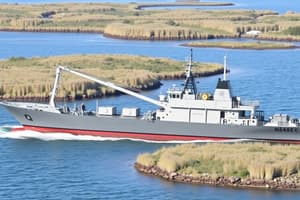Podcast
Questions and Answers
What does OP 5 cover?
What does OP 5 cover?
Ammunition and safety ashore.
What is DDESB and what is its purpose?
What is DDESB and what is its purpose?
Department of Defense Explosive Safety Board; its purpose is to establish and recommend safety standards that correct hazardous conditions associated with ammunition and ordnance operations.
What four program evaluation areas does the ESMP consist of?
What four program evaluation areas does the ESMP consist of?
Management, plans policies and procedures, execution/operations, execution/operations support.
Whose responsibility is it to exercise general supervision for explosive safety throughout the DON?
Whose responsibility is it to exercise general supervision for explosive safety throughout the DON?
How often must an ESO inspect explosive storage areas?
How often must an ESO inspect explosive storage areas?
What document governs explosive safety self-assessment?
What document governs explosive safety self-assessment?
Who has the authority to authorize deviations from explosive safety criteria, and who has he delegated his authority to?
Who has the authority to authorize deviations from explosive safety criteria, and who has he delegated his authority to?
How long is a waiver for deviating from mandatory explosive safety requirements good for?
How long is a waiver for deviating from mandatory explosive safety requirements good for?
How long is an exemption from mandatory explosive safety granted?
How long is an exemption from mandatory explosive safety granted?
What are the only two explosives to pass the required certification to be considered extremely insensitive detonating substances?
What are the only two explosives to pass the required certification to be considered extremely insensitive detonating substances?
What four components are typically needed for deliberate detonation of explosives?
What four components are typically needed for deliberate detonation of explosives?
What are the five tests conducted to determine the properties of naval explosives?
What are the five tests conducted to determine the properties of naval explosives?
What are the six types of hazard classification when speaking about explosives?
What are the six types of hazard classification when speaking about explosives?
When speaking about compatibility group descriptions, what is a Group A explosive?
When speaking about compatibility group descriptions, what is a Group A explosive?
What is a Group B explosive?
What is a Group B explosive?
What is a Group C explosive?
What is a Group C explosive?
What is a Group D explosive?
What is a Group D explosive?
What is a Group E explosive?
What is a Group E explosive?
What is a Group F explosive?
What is a Group F explosive?
What is a Group G explosive?
What is a Group G explosive?
What is a Group H explosive?
What is a Group H explosive?
What is a Group J explosive?
What is a Group J explosive?
What is a Group K explosive?
What is a Group K explosive?
What is a Group L explosive?
What is a Group L explosive?
What is a Group N explosive?
What is a Group N explosive?
What is a Group S explosive?
What is a Group S explosive?
What table explains group compatibility?
What table explains group compatibility?
In table 3-10, what does an 'X' represent?
In table 3-10, what does an 'X' represent?
What does a 'Z' represent in table 3-10?
What does a 'Z' represent in table 3-10?
What is ESQD?
What is ESQD?
At what psi is there a 50% chance of eardrum rupture?
At what psi is there a 50% chance of eardrum rupture?
What is the maximum amount of black powder you can store in a magazine?
What is the maximum amount of black powder you can store in a magazine?
What is the maximum amount of bulk explosives that can be stored?
What is the maximum amount of bulk explosives that can be stored?
What is the maximum amount of propellants that can be stored in a magazine?
What is the maximum amount of propellants that can be stored in a magazine?
What is the maximum amount of fixed ammunition that can be stored?
What is the maximum amount of fixed ammunition that can be stored?
How long do magazine inspection records have to be maintained?
How long do magazine inspection records have to be maintained?
What is the minimum distance a building can be to a burn pad?
What is the minimum distance a building can be to a burn pad?
Where must firefighting equipment be located during a burning operation?
Where must firefighting equipment be located during a burning operation?
What is the maximum wind speed for burning operations?
What is the maximum wind speed for burning operations?
What is the minimum distance for storage ammunition awaiting destruction from the burn pad?
What is the minimum distance for storage ammunition awaiting destruction from the burn pad?
What is the minimum amount of time after the final burn operation takes place personnel must stay on station?
What is the minimum amount of time after the final burn operation takes place personnel must stay on station?
How far must a vehicle remain from explosive material while on the burn pad?
How far must a vehicle remain from explosive material while on the burn pad?
How long must you wait after a burning operation has taken place to go back down range?
How long must you wait after a burning operation has taken place to go back down range?
How long between burns?
How long between burns?
How large of a radius must be cleared of combustibles for a detonation site? (non-training)
How large of a radius must be cleared of combustibles for a detonation site? (non-training)
For training site ranges, how far must combustibles be cleared?
For training site ranges, how far must combustibles be cleared?
What is the maximum new for a class D range?
What is the maximum new for a class D range?
What class of range does a training demo range fall under?
What class of range does a training demo range fall under?
How long must personnel stay on site after a demolition shot?
How long must personnel stay on site after a demolition shot?
What is the maximum amount of black powder that can be burned at a time?
What is the maximum amount of black powder that can be burned at a time?
What is the maximum amount of smokeless powder to be burned at one time?
What is the maximum amount of smokeless powder to be burned at one time?
Flashcards are hidden until you start studying
Study Notes
NAVSEA OP 5 Overview
- Covers ammunition and safety procedures ashore.
DDESB
- Stands for Department of Defense Explosive Safety Board.
- Establishes and recommends safety standards for ammunition and ordnance operations.
ESMP Program Evaluation Areas
- Consists of management, plans, policies and procedures, execution/operations, and execution/operations support.
General Supervision Responsibility
- Commanding Officer (CO) of the Navy Ordnance Safety and Security Agency (NOSSA) oversees explosive safety throughout the Department of the Navy.
Inspection of Explosive Storage Areas
- Explosive Safety Officers (ESO) must inspect storage areas annually.
Explosive Safety Self-Assessment Governance
- Governed by NOSSAINST 8020.14.
Authority for Deviations from Safety Criteria
- Secretary of the Navy holds authority, delegated to Chief of Naval Operations (CNO).
Waivers for Deviating from Safety Requirements
- Valid for up to 2 years.
Exemptions from Mandatory Safety Requirements
- Granted for no longer than 5 years.
Extremely Insensitive Detonating Substances
- Only PBXN-113 and PBXN AF-757 have passed required certification.
Components for Deliberate Detonation
- Requires a source of energy, initiating charge, booster, and main charge.
Tests for Naval Explosives Properties
- Include impact, gap, friction, vacuum, and electrostatic tests.
Hazard Classification Types for Explosives
- Mass explosion, fragment-producing non-mass explosion, mass fire/ minor blast, moderate fire, very insensitive explosive with mass explosion hazard, and extremely insensitive explosive article.
Compatibility Group Descriptions
- Group A: Bulk primary explosives.
- Group B: Detonators and initiating devices.
- Group C: Bulk propellant.
- Group D: Bulk high explosives or black powder.
- Group E: High explosives stored with propellant charge.
- Group F: High explosives or ordnance with initiation means.
- Group G: Incendiary and smoke munitions.
- Group H: White Phosphorus (WP) munitions.
- Group J: Munitions with flammable liquids.
- Group K: Munitions with toxic agents.
- Group L: Any munitions not previously classified.
- Group N: Extremely insensitive munitions.
- Group S: Munitions posing no significant hazard.
Group Compatibility Table
- Table 3-10 explains group compatibility.
- X indicates compatible groups; Z suggests mixture is allowable but not recommended.
Explosive Safety Quality Distance (ESQD)
- Refers to required distances regarding explosive safety.
Eardrum Rupture Risk
- 50% chance of eardrum rupture at 16 psi.
Maximum Storage Capacities
- 50,000 lbs for black powder and bulk explosives.
- 1,000,000 lbs for propellants.
- 500,000 lbs for fixed ammunition.
Magazine Inspection Records
- Must be maintained for 4 years.
Distance Requirements
- Minimum distance from a burn pad to building: 100 ft with a barricade, 500 ft without.
- Firefighting equipment must be on-site or within 5 minutes during burning operations.
- Maximum wind speed for burning operations: 15 mph.
- Minimum distance for storage ammunition awaiting destruction from burn pad: 500 ft.
Personnel Safety Post-Operation
- Personnel should remain on-site for 30 minutes after the final burn operation.
- Vehicles must stay 50 ft away from explosive material on the burn pad.
- Wait 5 minutes after the last smoke before going downrange.
Burn Timing and Radius Safety
- Minimum waiting time between burns: 2 hours with wet down, 4 hours without.
- Clear 500 ft radius of combustibles for detonation sites, and 50 ft for training sites.
Range Classifications
- Class D range maximum for new explosives: 25 lbs.
- Training demo range also classified as Class D.
- Personnel must stay on-site for 60 minutes after a demolition shot.
- 25 lbs is the maximum amount of black powder that can be burned at once.
- Maximum smokeless powder to be burned at one time: 4,000 lbs.
Studying That Suits You
Use AI to generate personalized quizzes and flashcards to suit your learning preferences.




